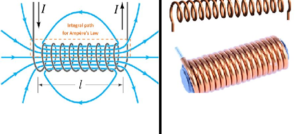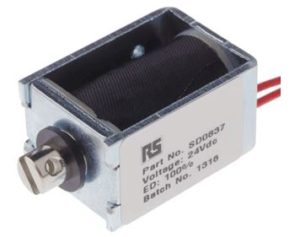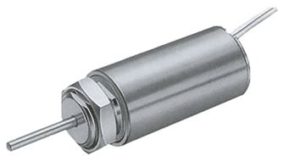Solenoids are simple components that can be used for various applications. The name solenoid is derived from the Greek word “Solen” which means a channel or a pipe. Solenoids are used in both domestic and industrial equipments, they are available in various designs, each of them has their own specific applications. Although the application changes, their working principle always remains the same. Here we will discuss about Solenoid working and different types of Solenoid.
What is a solenoid?
A solenoid is a device comprised of a coil of wire, the housing and a moveable plunger (armature). When an electrical current is introduced, a magnetic field forms around the coil which draws the plunger in. More simply, a solenoid converts electrical energy into mechanical work.
- The coil is made of many turns of tightly wound copper wire. When an electrical current flows through this wire, a strong magnetic field/flux is created.
- The housing, usually made of iron or steel, surrounds the coil concentrating the magnetic field generated by the coil.
- The plunger is attracted to the stop through the concentration of the magnetic field providing the mechanical force to do work.
The solenoid can create a magnetic field from electric current and this magnetic field can be used to generate a linear motion with the help of a metal core. This simple device can be used as an electromagnet, as an inductor or as a miniature wireless receiving antenna in a circuit.
Working Principle
The solenoid simply works on the principle of “electromagnetism”. When the current flow through the coil magnetic field is generated in it, if you place a metal core inside the coil the magnetic lines of flux is concentrated on the core which increases the induction of the coil as compared to the air core. This concept of electomagnatic induction has been more elaborated in our previous Tesla coil project.

Most of the flux is concentrated only on the core, while some of the flux appears at the ends of the coil and a small amount of flux appears outside the coil.
The magnetic strength of the solenoid can be increased by increasing the density of the turns or by increasing the current flow in the coil.
Like all other magnets the activated solenoid has both Positive and Negative poles, through which an object can be attracted or repelled.
Types of Solenoids
There are different types of solenoids available in the market, the classification is made based on material, Design and function.
- AC- Laminated Solenoid
- DC- C Frame Solenoid
- DC- D Frame Solenoid
- Linear Solenoid
- Rotary Solenoid
1. AC Laminated Solenoid
The AC laminated Solenoid consist of a metal core and a coil of wire. The core is constructed with a laminated metal in order to reduce the stray current, this helps in improving the performance of the solenoid.

An AC solenoid has a special advantage because it can deliver a large amount of force in the first stroke. This is because they have an inrush current (An instantaneous high input current drawn by a power supply or electrical equipment when turn-on). They are capable of using more strokes than a DC laminated solenoid.
They are available in different configurations and ranges and they produce a clean buzzing sound when they are in operation.
An AC Laminated solenoid can be used in a variety of equipments that require immediate action, such as medical equipments, locks, vehicles, industrial equipments, printers, and in some of the household Appliances.
2. DC C-Frame Solenoid
The C frame refers to the design of the solenoid. The DC C-Frame solenoid has only a frame in the shape of the letter C which is covered around the coil.

The DC C-Frame solenoid is used in multiple day to day applications because of it more controlled stroke operation. Although it is said to be DC configuration but they can also be used in equipments designed for AC power.
This type of solenoid is mainly used in gaming machines, Photographic shutters, Scanners, Circuit breakers, Coin counters and Bill changers.
3. DC D-Frame Solenoid
This type of solenoid has a two piece frame covering the coils. They have similar function like a C-frame solenoid hence the D-frame can also be used with AC power and has a controlled stroke operation.

The DC D-frame solenoid is used for both conventional and medical applications such as gaming machines, ATM machines and Blood and gas Analyzer.
4. Linear Solenoid
The linear solenoids are more familiar among the people. It consist of a coil of wire which is wrapped around a movable metal core which helps us to apply pulling or pushing force to a mechanical device.
This type of solenoids is mostly used on starting devices. This switching mechanism helps in completing a circuit and allows the current to flow thorough a mechanism.

The linear solenoids are especially used in the automation and Highly secured door mechanisms and starter motors of cars & bikes.
5.Rotary Solenoid
A rotary solenoid is a unique type of solenoid which is used for various applications where there is a need for easy automatic control process. It works on the same principle as the other solenoids and has the same elements, a coil and a core, but they have a different operation.

The metal core is mounted to a disk and has small grooves under it, The size of the grooves exactly matches with the slots in the body of the solenoid. It also has ball bearings to make easy motion.
When the solenoid gets triggered the core is drawn into the body of the solenoid and the disc core start rotating. This setup will have a spring place in between the core and the body of the solenoid. Once the power supply is detached the spring pushes the disk core to its original position.
The rotary solenoid is more robust when compared to all other types of solenoids. They were originally designed only for the defence mechanisms, but nowadays you will be able to find them in many automated industrial mechanisms such as laser and shutter.
Applications of Solenoid
- A solenoid is an essential coil of wire that is used in electromagnets, inductors, antennas, valves, etc. The application of a solenoid differs in numerous types like medical, locking systems, industrial use, the bottom line and Automotive Solenoid Applications.
- A solenoid is used to control a valve electrically, for example, the solenoid core is used to apply mechanical force to the valve.
- These can also used in particular types of door locking systems, which use an electromagnet and offer a very secure closure.
- The solenoid is used in many different appliances and products like computer printers, fuel injection gear used on cars and in various industrial settings.
- The main advantage of the solenoid is, whenever an electricity is applied, the reaction of the solenoid is immediate.
- That quick response is one of the most significant factors in resolving the applications of solenoids.